Podcast
Questions and Answers
What is the first step in converting a decimal number to binary?
What is the first step in converting a decimal number to binary?
- Divide by 2. (correct)
- Multiply by 2.
- Add 1 to the decimal number.
- Record the remainder after dividing by 8.
How do you convert a binary number to its octal equivalent?
How do you convert a binary number to its octal equivalent?
- Group binary digits in sets of two.
- Convert each binary digit to its decimal value.
- Group binary digits in sets of four.
- Group binary digits in sets of three. (correct)
Which of the following is NOT a digit used in the hexadecimal number system?
Which of the following is NOT a digit used in the hexadecimal number system?
- F
- G (correct)
- 9
- A
What operation is performed with each digit when converting octal to decimal?
What operation is performed with each digit when converting octal to decimal?
What is the highest digit in the octal number system?
What is the highest digit in the octal number system?
When converting hexadecimal to decimal, what is the base that each digit is multiplied by?
When converting hexadecimal to decimal, what is the base that each digit is multiplied by?
How do you start the conversion of binary to hexadecimal?
How do you start the conversion of binary to hexadecimal?
What is the main reason for performing base conversions in computer systems?
What is the main reason for performing base conversions in computer systems?
What process is used for converting decimal numbers to octal?
What process is used for converting decimal numbers to octal?
In place value concepts, how does the importance of a digit change in a number?
In place value concepts, how does the importance of a digit change in a number?
Flashcards are hidden until you start studying
Study Notes
Conversion of Number System
1. Number Systems Overview
- Binary (Base 2): Uses digits 0 and 1.
- Decimal (Base 10): Uses digits 0-9; the most commonly used system.
- Octal (Base 8): Uses digits 0-7.
- Hexadecimal (Base 16): Uses digits 0-9 and letters A-F (10-15).
2. Conversion Techniques
A. Decimal to Other Bases
-
Decimal to Binary:
- Divide the decimal number by 2.
- Record the remainder.
- Continue dividing the quotient by 2 until it reaches 0.
- Read the remainders backward for the binary representation.
-
Decimal to Octal:
- Divide the decimal number by 8.
- Record the remainder.
- Repeat until the quotient is 0.
- Read the remainders backward for the octal representation.
-
Decimal to Hexadecimal:
- Divide the decimal number by 16.
- Record the remainder (0-9, A-F).
- Continue until the quotient is 0.
- Read the remainders backward for the hexadecimal representation.
B. Other Bases to Decimal
-
Binary to Decimal:
- Multiply each bit by 2 raised to the power of its position (starting from 0).
- Sum all the values.
-
Octal to Decimal:
- Multiply each digit by 8 raised to the power of its position.
- Sum all the values.
-
Hexadecimal to Decimal:
- Multiply each digit by 16 raised to the power of its position.
- Sum all the values.
C. Between Non-Decimal Bases
-
Binary to Octal:
- Group binary digits in sets of three (from right).
- Convert each group to its octal equivalent.
-
Binary to Hexadecimal:
- Group binary digits in sets of four (from right).
- Convert each group to its hexadecimal equivalent.
-
Octal to Binary:
- Convert each octal digit to its 3-bit binary equivalent.
-
Hexadecimal to Binary:
- Convert each hexadecimal digit to its 4-bit binary equivalent.
3. Key Concepts
- Place Value: Each digit's value depends on its position and base.
- Base Conversion: Essential for computer systems, data representation, and programming.
- Radix: Another term for the base of a number system.
4. Practical Applications
- Data representation in computers (e.g., memory addressing).
- Programming (especially in low-level languages).
- Networking (e.g., IP address notation in hexadecimal).
Number Systems Overview
- Binary (Base 2): Comprises only the digits 0 and 1, integral for digital circuit design.
- Decimal (Base 10): Utilizes digits from 0 to 9; prevalent in daily life and commerce.
- Octal (Base 8): Uses digits ranging from 0 to 7; often applied in computing as a shorthand for binary.
- Hexadecimal (Base 16): Combines digits 0-9 with letters A-F to represent values 10-15; utilized in memory addresses and color codes.
Conversion Techniques
-
Decimal to Binary:
- Divide the decimal by 2 repeatedly and record the remainders.
- Read the recorded remainders backward to obtain the binary form.
-
Decimal to Octal:
- Divide the decimal by 8 repeatedly and note the remainders.
- Find the octal equivalent by reading remainders backward.
-
Decimal to Hexadecimal:
- Divide the decimal by 16, recording remainders in the range of 0-9 and A-F as necessary.
- Convert assembled remainders backward into hexadecimal format.
-
Binary to Decimal:
- Calculate the sum of each bit multiplied by 2 raised to its respective positional power.
-
Octal to Decimal:
- Multiply each octal digit by 8 raised to its positional power and sum the results.
-
Hexadecimal to Decimal:
- Multiply each digit by 16 raised to its positional power; total the outcome.
-
Binary to Octal:
- Group binary digits into sets of three from the right and convert each set into octal.
-
Binary to Hexadecimal:
- Group binary digits in sets of four from the right for conversion to hexadecimal.
-
Octal to Binary:
- Transform each octal digit into its equivalent 3-bit binary form.
-
Hexadecimal to Binary:
- Convert each hexadecimal digit into a corresponding 4-bit binary representation.
Key Concepts
- Place Value: Determines a digit's worth based on its position in relation to its base.
- Base Conversion: Crucial for computer architecture, data encoding, and software development.
- Radix: An alternative term used to refer to the base of a numerical system.
Practical Applications
- Essential for data representation in computer systems, influencing memory and storage design.
- Fundamental in programming, notably in low-level languages where hardware interaction is critical.
- Significant in networking, especially for formatting IP addresses using hexadecimal notation.
Studying That Suits You
Use AI to generate personalized quizzes and flashcards to suit your learning preferences.




